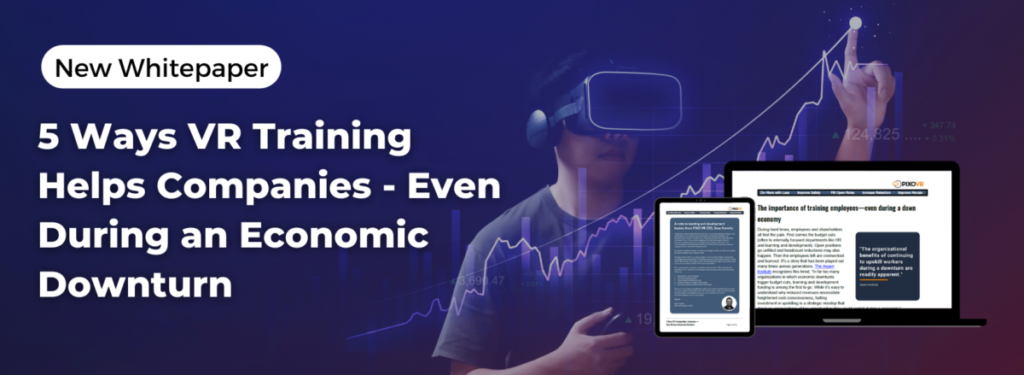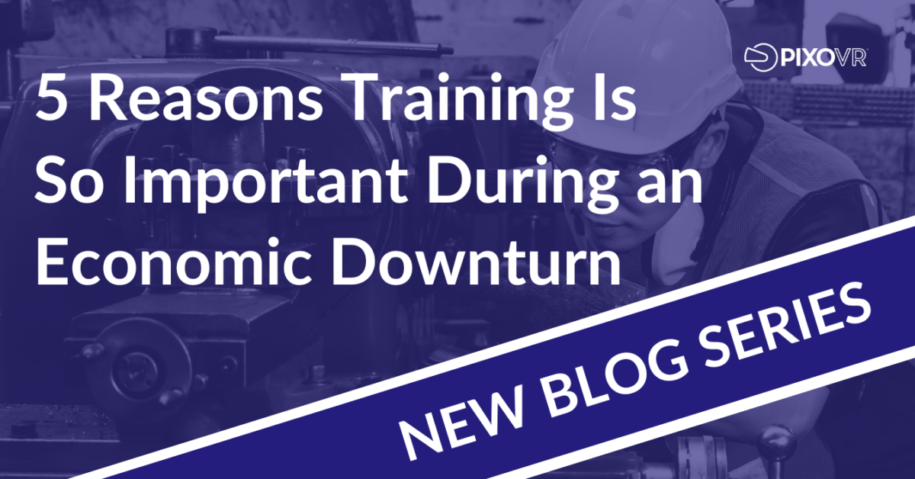The following is an excerpt from our whitepaper: ‘5 Ways VR Training Helps Companies Even in an Economic Downturn’:
Learning and development. When times are tough, it’s typically one of the first budgets to get cut. Yet the gains to doing this are extremely short term. Reducing the investment in making sure employees have the skills needed to do their jobs well and safely is dangerous for a company. This is true in any economy, but is especially true in an economic downturn because it will exacerbate the company’s problems.
This article explains why cutting learning and development budgets is a mistake in today’s economic climate and how investing in VR training can actually help companies realize the cost savings needed.
Why training budgets should be protected
When financial pressures hit organizations, the first round of budget cuts is often internal-focused in areas like HR and learning and development. Hiring freezes leave positions unfilled. Headcount reductions add to the burden on existing employees, causing them to become overworked, stressed, and unappreciated. In an era where many employees can easily leave to find new work, this is a dangerous situation for companies to be faced with.
The Aspen Institute recognizes this trend, “In far too many organizations in which economic downturns trigger budget cuts, learning and development funding is among the first to go. While it’s easy to understand why reduced revenues necessitate heightened cost-consciousness, halting investment in upskilling is a strategic misstep that deprives organizations of key opportunities they could exploit during a recession.”
Companies need to reconsider traditional notions of what budget cuts cause the least short term pain and instead consider which areas should be continued or even see higher investment to prepare the company to successfully get through an economic decline. A Gallup study of high-performing workplaces showed that companies that make a strategic investment in employee development are twice as likely to retain their people, while also increasing profitability by 11%.
Will investing in training really make a difference during a poor economy?
The answer is yes. Investing in learning and development can actually reduce costs, yielding those budget reductions the company may need to weather difficult economic conditions. The Aspen Institute commented that companies that invest in learning and development during an economic downturn “are taking a conscious step to remain among those most able to communicate a strong employer brand and compete for top talent during times when wages and other benefits are likely to remain stagnant.”
That sounds great, but companies need P&L bottom line improvements and those can be found, but not with traditional training. If a company has been stuck training the same way they’ve been doing it for years, this is a hard concept to get behind — classroom style with a teacher and a detached student. Even if a company has moved to video and online learning, the concept is still the same. Employees are expected to absorb material and regurgitate it back.
This isn’t how people truly learn.
You can’t give a 17 year old a 20-page pdf and expect them to read and learn concepts any more than you can expect that a senior manager can master harassment discussions or that a new employee can learn a technical skill without practice. Even job shadowing still assumes a person can learn by seeing, not by doing.
True learning comes from practicing a skill in the environment they need to use it.
This type of immersive learning comes from virtual reality (VR).
What cost reductions can be seen with VR training?
Incorporating VR technology that engages employees and radically improves skill retention into existing employee learning and development programs can make a major impact on an organization. VR learning is a smart investment for companies dealing with the challenges of an economic downturn or to help fuel growth when the economy is good.
Here are five key benefits companies can realize by investing in VR training:
- Reducing the costs of training – There are many training needs that require a special environment or specific equipment to train. This often incurs high costs for instructor and/or employee travel, shipping special equipment, shutting down production equipment, or the cost of recreating a real-life scenario. VR training eliminates the need for all of these costs with the ability to create life-like simulations that provide employees with hands-on experience without the added cost.
- Improving employee safety – Keeping employees safe is great for employee happiness, but definitely impacts bottom line costs. Reducing workplace accidents keeps employees on the job and productive. It also reduces OSHA fines and disability costs. All of this adds up to higher production and less expense.
- Overcoming the skilled labor gap – A lack of skilled labor is a big problem across many industries that will only be made worse with hiring freezes and budget cuts. Hiring unskilled labor and trying to train them using traditional methods is resulting in mistakes that have big costs to fix. VR training is faster and more effective at training hard skills than traditional training methods. Bringing VR content into employee training can reduce the skills gap and keep mistakes low.
- Keeping employees engaged and retained – When the hiring freezes hit, valuable employees can get burned out. Next comes ‘quiet quitting’ or an actual exodus. Losing employees is a costly proposition of around 30% of the employee’s salary to find a replacement, let alone the cost of lost productivity and additional burden on others. To keep from losing these employees, companies need to continue to invest in their development. VR can play a big role here with hard and soft skills training that can improve employee engagement as well as make employees feel valued.
- Improving employee culture and job satisfaction – Going hand in hand with retention is keeping the employee culture strong during difficult times. This goes beyond skills training to looking for ways to improve diversity, inclusion, and employee wellness. There is a wealth of VR content for helping employees embrace these difficult topics, as well as reduce stress with guided meditation and wellness exercises. The same headsets used for skills training can be extended for employee development that keeps employees smiling amongst the challenges they face day-to-day. This increases productivity and keeps the company performing at the high levels needed to persist through the down economy.
Companies need to look to learning and development as a key function to weather the storm or even help a company thrive despite economic conditions. VR training can bring positive change and bottom line cost savings for companies looking for a strategic win in any economy.
Wondering how to get started with VR training?
For learning and development leaders looking to help their company’s thrive, VR training is the answer. VR content naturally compliments existing training content to provide employees with ways to apply and practice skills needed to be successful.
Want more evidence for leadership on the cost cutting benefits of VR training? Read whitepaper here!
In our previous whitepaper we covered how to bring VR into your training program, get the step-by-step guide here!
Download the whitepaper: 5 Ways VR Training Helps Companies Even in an Economic Downturn’:


Leave a Reply
You must be logged in to post a comment.